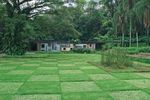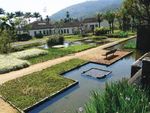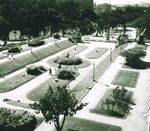GALLERY GUIDE - Roberto Burle Marx Brazilian Modernist May 6 - September 18, 2016 - Stephen Friedman Gallery
←
→
Page content transcription
If your browser does not render page correctly, please read the page content below
Exposed to a wide range of cultural
influences from an early age,
Roberto Burle Marx was a
multifaceted artist who drew
extensively from established
1.
principles of landscape architecture
while also working to reinvent
the discipline.
A companion to the exhibition, this
guide provides a closer look at the
diverse ideas Burle Marx explored as
3.
he revolutionized garden design and
artistic expression in Brazil.
2.
IRREGULAR FORMS
Brazil’s gardens in the late 19th and early from European tradition, introducing
20th centuries largely followed French free-form plantings and incorporating
landscape design, which is distinctively texture as a key element. His 1979 plan
symmetrical and formal. The layout of for the private garden of Fazenda Vargem
Quinta da Boa Vista (1), a public park in Grande (Clemente Gomes residence) (3)
Rio de Janeiro planned by Auguste François in Areias is a thoroughly modern tribute to
Marie Glaziou in the 1870s, evokes the Renaissance water gardens — a celebration
gardens of Versailles in France. While of flat terraces, waterfalls, and rain pools
Roberto Burle Marx’s designs sometimes arranged in an asymmetrical composition.
embraced French tenets, many diverged Burle Marx’s irregular designs transformed
from such uniformity. In 1938, his design the practice of landscape architecture in
for the gardens of the Ministry of Education Brazil and worldwide.
and Health (2) in Rio de Janeiro broke away“When I see something like [Victoria
amazonica water lilies] I start to believe
that life has meaning. I believe that my
life was not wasted, I prevented the
destruction of many plants . . . And
when I look at these plants, this water,
and this hill, I can say: I am a rich man.”
— Roberto Burle Marx
7.
4.
5.
6. 8.
NATIVE PLANTS BRAZILIAN MODERNISM
Traditional Brazilian landscape design relied (Clemente Gomes residence) (5) in Areias Roberto Burle Marx’s use of local vegetation Burle Marx’s inclusion of regional plants —
on imported plant life, including European highlighted the remarkable and expansive not only related to his horticulturist ideals, such as thorny vegetation from the semiarid
roses and gladioli, as illustrated by Claude Victoria amazonica water lilies. Throughout but also aligned with his contemporaries who Caatinga of northeastern Brazil in his 1935
Monet in his c. 1876 painting Gladioli (4). his life, Burle Marx advocated passionately in the early 1930s were reconciling modernist Madalena Cactus Garden, Euclides da Cunha
Roberto Burle Marx’s use of flora original to for the environment. To this day, Sítio art with Brasilidade or Brazilian identity. Such Square (8) — identifies him as a quintessential
his homeland, such as the billowing foliage Roberto Burle Marx (6), the artist's former artists explored Brazilian modernism by Brazilian modernist.
of the Amazon and Atlantic rainforests, was home, preserves his collection of tropical depicting native cacti, such as Tarsila do
innovative. His 1979 plan for the private and semitropical plants — one of the largest Amaral in her paintings and Lasar Segall in his
garden of Fazenda Vargem Grande in the world. 1928 Two Mangue Women with Cactus (7).PUBLIC PROGRAMS EXPLORING THE EXHIBITION
GALLERY TALKS
Discussions related to the exhibition, led by Jewish Museum educators.
Spiritual Modernism From 2D to 3D and Back Again
Fridays, May 13, June 24, Friday, June 10, and
and September 9, 2 pm Tuesday, July 5, 2 pm
9.
The Abstract Landscape Free with Museum Admission;
Fridays, May 20 and September 16, RSVP Recommended
10.
and Tuesday, July 19, 2 pm
BANG ON A CAN: ADULT STUDIO WORKSHOP:
PERFORMANCE BY ARTO LINDSAY THE PLAYFUL LANDSCAPE
Thursday, May 12, 7:30 pm Sunday, July 10, noon – 5 pm
Inspired by the exhibition, this performance Using the environment as inspiration,
echoes themes of cultural experimentation investigate composition and abstraction in
and cross-pollination between American and a class taught by artist Mark Joshua Epstein.
Brazilian rock and pop music.
Course Fee: $65 General; $50 Members
Tickets: $18 General; All materials included
$15 Students and Seniors;
$12 Jewish Museum and
Bang on a Can Members
COCKTAILS AT COOPER HEWITT
Select Thursdays, 6 — 9 pm
Visit our neighbor for an evening of Brazilian
THIS IS HOW WE DO IT music, cocktails, and dancing. Presented by
Tuesday, May 17, 2 pm Cooper Hewitt, Smithsonian Design Museum,
Rebecca Shaykin, Leon Levy Assistant Curator, in collaboration with the Jewish Museum.
speaks about the contemporary art included
For more information, visit
11. in the exhibition. This program features
CooperHewitt.org/Events.
ASL interpretation.
Tuesday, September 13, 2 pm
ABSTRACTION Claudia Nahson, Morris & Eva Feld Curator,
discusses the process of organizing the
MAS QUE NADA:
BRAZILIAN ART SINCE THE 1960S
exhibition.
Thursday, September 8, 6:30 pm
Although his paintings and drawings from Burle Marx often utilized strict geometry, Free with Museum Admission; This program considers the state of
the 1930s and early 1940s are primarily as in his 1956 design for the gardens of the RSVP Recommended contemporary art in Brazil since the
figurative, Roberto Burle Marx — who began former Francisco Pignatari residence (now 1960s with a focus on the history of the
his career as a painter — soon started Parque Burle Marx) (10) in São Paulo. His São Paulo Biennial.
flirting with abstraction. His design for 1983 mineral roof garden of the Banco Safra
Free with Pay-What-You-Wish Admission;
the gardens of the Ministry of Education headquarters (11) in São Paulo, with its
RSVP Recommended
and Health (2) reveals the extent to which bold, nonrepresentational pavement,
Burle Marx channeled Joan Miró and acts as a foil for the surrounding Brutalist
Jean Arp, such as the latter’s 1917 Enak’s high-rise buildings. Reservations at TheJewishMuseum.org/Calendar, 212.423.3337, or the admission desk.
Tears (Terrestrial Forms) (9). In the 1950s, For information on Access Services, including assistive listening devices and wheelchairs, visit TheJewishMuseum.org/Access.5th Ave at 92nd St, NYC
TheJewishMuseum.org
Roberto Burle Marx: Brazilian Modernist is made possible by
Deutsche Bank, The Emanuel and Riane Gruss Charitable
Foundation, an anonymous donation in memory of Curtis Hereld,
and the Graham Foundation for Advanced Studies in the Fine Arts.
Additional support is provided by the Leon Levy Foundation.
Public programs are made possible by endowment support from the William Petschek
Family, the Trustees of the Salo W. and Jeannette M. Baron Foundation, Barbara and
Benjamin Zucker, the late William W. Hallo, the late Susanne Hallo Kalem, the late Ruth
Hallo Landman, the Marshall M. Weinberg Fund with additional support from Marshall M.
Weinberg, the Rita J. and Stanley H. Kaplan Foundation, the Saul and Harriet M. Rothkopf
Family Foundation, and Ellen Liman.
Additional support is provided by Lorraine and Martin Beitler and through public funds
from the New York City Department of Cultural Affairs.
The Jewish Museum is under the auspices of The Jewish Theological Seminary.
Cover: Roberto Burle Marx, early 1980s. © Hedgecoe / TopFoto / The Image Works. |
Image 1: Auguste François Marie Glaziou, Quinta da Boa Vista, Rio de Janeiro, 1869 – 1878.
Quapa Project. | Image 2: Rooftop Garden of the Ministry of Education and Health,
designed by Roberto Burle Marx, Rio de Janeiro, 1938. Photograph © Cesar Barreto. |
Image 3: Garden of the Clemente Gomes residence, Fazenda Vargem Grande, Areias,
designed by Roberto Burle Marx, 1979. © Burle Marx Landscape Design Studio, Rio de
Janeiro. Reproduced with permission. All rights reserved. | Image 4: Claude Monet,
Gladioli, c. 1876, oil on canvas. | Image 5: Victoria amazonica water lilies, garden of the
Fazenda Vargem Grande, Clemente Gomes residence, Areias, designed by Roberto Burle
Marx, 1979. © Burle Marx Landscape Design Studio, Rio de Janeiro. Reproduced with
permission. All rights reserved. | Image 6: Gardens of the Sítio Roberto Burle Marx, Rio
de Janeiro. © Malcolm Raggett. | Image 7: Lasar Segall, Two Mangue Women with
Cactus, 1928, drypoint. Museu Lasar Segall — Iphan / Ministério da Cultura. |
Image 8: Madalena Cactus Garden, Euclides da Cunha Square, Recife, 1935, ink on
paper. Image provided by Sítio Roberto Burle Marx, Rio de Janeiro. | Image 9: Jean
(Hans) Arp, Enak’s Tears (Terrestrial Forms), 1917, painted wood. MoMA. Benjamin Scharps
and David Scharps Fund and purchase MoMA, 1197.1979. © Artists Rights Society (ARS),
New York / VG Bild-Kunst, Bonn. | Image 10: Gardens of the former Francisco Pignatari
residence, now Parque Burle Marx, São Paulo, 1956. Photograph © Cesar Barreto. |
Image 11: Mineral roof garden, Banco Safra headquarters, São Paulo, designed by
Roberto Burle Marx, 1983. Photograph © Leonardo Finotti.You can also read

























































